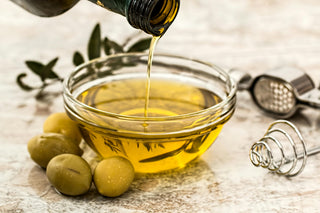The day is finally here; you have cleared your schedule, readied your arms for the battle ahead, and are about to head into wash day. You check your decorative cabinet and realize you have run out of your favorite shampoo, deep conditioner, or gel. Maybe you do not have enough time to replace it or just cannot afford it at the moment. Do not worry; you can DIY most of your hair wash day regimen, and we have a list of recipes to help you out.
When creating your hair products, it is vital to keep in mind your allergies and hair goals; is it adding moisture, reducing shedding, or adding shine? Do not forget your hair porosity; if it is lower, you might want to shy away from heavier and thicker ingredients to prevent build-up mainly in the styling stage. Not only will this process help you save your coin, sis, but improve your health, since you know precisely what is in your hair product.
1. Aloe Vera & Olive Oil
2. African Black Soap
3. Apple Cider Vinegar
4. Banana & Honey Mask
5. Egg & Mayonnaise
6. Aloe Vera Juice, Coconut Water, and Jojoba Oil
7. Shea Butter Balm with Honey
Stage 1: Pre-Poo
Among different types of curly hair women, pre-poo is a critical step in wash day. In contrast, others tend to ignore it completely. This process often involves applying some form of treatment, usually in the form of oils to act as a protective layer before you cleanse your hair. If you decide to incorporate this step and do it yourself, try ingredients that are moisture-focused and boost your hair cuticle's health. Below is one of my favorite pre-poo recipes:
Aloe Vera & Olive Oil
With just two ingredients, you can add smoothness and shine to your hair. Aloe Vera is a natural girl must-have. It has vital enzymes that: repair dead skin on the scalp, reduce dandruff, and itchiness promote hair growth, and improve your hair elasticity, therefore, reducing breakage. Combined with olive oil straight from your kitchen cabinet will leave your hair feeling soft and moisturized.
Method
-
Clean your Aloe vera leaf and cut off its edges. Discard the poisonous white part.
-
Cut the leaf in half, scrapping the Aloe gel into a bowl.
-
Blend the gel under pulse settings until foamy. Add Aloe vera juice instead of water if needed.
-
Using a pantyhose, strain the blended Aloe into an applicator bottle.
-
Apply the Aloe vera directly onto your scalp and massage it in.
-
Apply the olive oil to the strands of your hair.
-
Leave on for 30 minutes and rinse thoroughly with warm water.
Stage 2: Cleansing
When it comes to black natural hair textures, the general rule of thumb is to avoid over-cleansing our hair as it tends to encourage dryness. This step is still crucial in our biweekly wash day routine as a clean scalp reduces itchiness, removes build-up, and prevents flaking. While creating any organic cleanser, make sure you are mindful of the pH levels; too acidic will make it hard to moisturize your hair. Too alkaline your hair will struggle with retaining moisture. You can test this with pH strips. The benefit of organic cleansers is they do not strip your hair as much as traditional shampoos. So, say goodbye to straw-like hair with my top DIY shampoos:
African Black Soap
Derived from the motherland, this soap is a conglomeration of dried skin from cassava and cocoa pods, plantains, palm tree leaves, plus shea tree bark. This combination packs the soap with necessary antioxidants, vitamin A and E, plus minerals like potassium which nourishes and moisturizes our hair. This recipe defines au natural and provides benefits such as softening our hair and defining our curl pattern without exposing you to toxins.
Method
1. Get an ounce of African black soap and grate it into a jar.
2. Fill the jar with warm water depending on desired consistency.
3. Add your favorite essential oils like Tea tree oil, Argan oil or, Jojoba Oil.
4. Apply, lather, and rinse.
Apple Cider Vinegar
If you are looking for a recipe that will really clarify your hair, this two-step recipe will have you saying goodbye to store-bought shampoos. Apple Cider Vinegar has anti-inflammatory properties, promoting a healthy scalp, reducing chances for dandruff, and eases the detangling process.
Method
-
Miz 1 part Apply Cider Vinegar and 3-part Water into an applicator bottle and shake.
-
Apply directly onto the scalp while massaging it in.
-
Rinse until the water flows clear from your hair.
Stage 3: Deep Conditioner / Protein Treatment
Treating our hair is the pinnacle of any wash day, as we get to replenish and strengthen our hair after the week's wear and tear. This step is vital for all hair types, from those with natural 3a curly hair to those 4c afro curl texture; we all deserve to spoil our hair. When picking a treatment, you have the choice to use a protein treatment, a deep conditioner, or both.
Protein treatments are ideal when your hair goal is to strengthen your hair and reduce shedding since they fill in your hair cuticle gaps. In contrast, deep conditioners often focus on rejuvenating our hair, and keeping it hydrated. Be careful to avoid protein overload and over-moisture (hygral fatigue) which typically results in loss of curl pattern from the constant change of wet to dry). Therefore, note your hair's current state before picking which recipe to try.
Moisture: Banana & Honey Mask
Bananas is one of those underrated ingredients when it comes to combating dry hair. This fruit is filled with potassium and vitamin A, which will be sure to make your curls pop. When combined with honey, a natural humectant, this concoction will leave your hair moisturized and manageable.
Method
-
Blend 1 Ripe Banana with two tablespoons of olive oil until smooth
-
Mix 1 tablespoon of honey
-
Strain mixture into a bowl and apply generously onto hair
-
Leave in for 30 minutes; use a plastic cap if needed. Rinse thoroughly.
Protein Mask: Egg & Mayonnaise
This protein-based nutrient-rich recipe is designed to promote healthy, thick hair and should be used sparingly. Eggs are jampacked with nutrients like vitamin A, E, and biotin, which play a critical role in maintaining our hair health. Simultaneously, mayonnaise consists of protein, fatty acids, and vitamins that will add sheen to your hair, leaving it smooth to the touch.
Method
-
Combine 1 egg and 2 Tablespoons of mayonnaise and form a smooth paste
-
Apply to hair and leave on for 30 minutes
-
Rinse thoroughly with cold water and follow with a conditioner.
Stage 4: Leave-In Conditioners
Indeed, organic ingredients are great for our hair. Still, we must be cautious in the styling stage not to use thick ingredients to accelerate buildup or cause flaking. Some of my favorite combinations include:
Aloe Vera Juice, Coconut Water, and Jojoba Oil
Great for added moisture, the aloe vera juice promotes hair growth, and jojoba oil prevents the formation of dandruff.
Method
-
Mix 1.5 cups of Aloe Vera Juice, 2 cups of coconut water, and 2 teaspoons of jojoba oil into a spray bottle.
Shea Butter Balm with Honey
If you need a DIY styling cream for your braid out, twist outs, or next Flexi rod, this recipe is the way to go. As the two main ingredients provide moisture and make their hair soft.
Method
1. Melt 1 ounce of shea butter and 1 ounce of coconut oil together
2. Add 1 teaspoon of honey and essential oil of choice.
Stage 5: Oils
Creating your own oils can prove challenging and tedious. That is why I recommend consulting your kitchen cabinet for your next hair oil and considering essential oils. Some oils I recommend are:
-
Olive Oil: To increase hair sheen and add moisture.
-
Avocado Oil: To strengthen hair roots and promote a healthy scalp/
-
Castor Oil: Promotes hair growth by reducing breakage.
-
Tea Tree Oil: Relieves itchy scalps and reduces dandruff. Always mix this oil, never apply directly to the scalp.
-
Lavender Oil: Promote hair thickness.
There you go, an extensive list of different recipes you can use on your next wash day. I hope these DIY products help you learn more about your hair and achieve your desired outcome.

